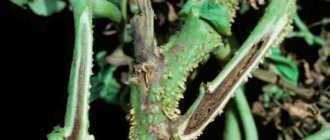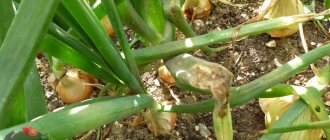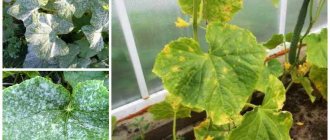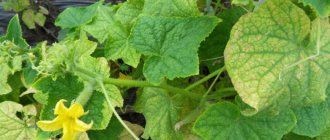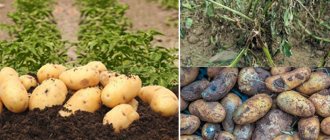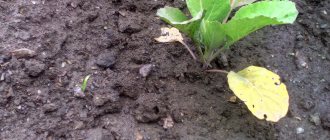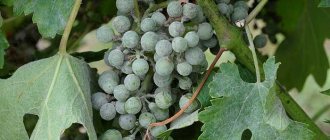What kind of disease is this
Mosaic is a viral disease that affects tissue at the cellular level . Chloroplasts are damaged and chlorophyll is destroyed. At the same time, the processes of photosynthesis and the formation of nutrients are inhibited. Areas of tissue die and the plant dies.
The pathogen attacks many plants : cucumbers, tomatoes, cabbage, peppers, tobacco and others.
For reference . The virus remains viable in soil for decades.
How does it show up on cucumbers?
Mosaicism can be diagnosed by light (white or yellow) spots on the leaves . Over time, the affected leaf plates become deformed and dry out. Some types of mosaics lead to the appearance of dark green stains on the tops.
The virus also affects the fruits : cucumbers become distorted, become stained and become bitter.
Why is it dangerous?
Mosaic viruses are not dangerous to humans . Damage consists of partial or complete loss of yield due to the pathogen.
The spread and persistence of the infection threatens the well-being of healthy plants and future plantings.
The insidious CMV virus
CMV causes the disease common mosaic. Affects young greenhouse plants. It is easy to determine the onset based on the symptoms. The condition of the leaves should be assessed:
- the plates become marble in places;
- the color of the affected leaf successively changes to light green, dark green, yellowish;
- the edges roll down;
- the distance between the plates decreases;
- leaves become smaller;
- the plant slows down;
- the ovaries fall off;
- the plant stem cracks lengthwise (in severe cases).
The lesion has a mosaic structure. The scale of the disease depends on the resistance of the variety or hybrid, climatic conditions (humidity and temperature in the greenhouse), and the degree of neglect. There is no treatment for mosaic on cucumbers. The gardener should prevent infection when planting.
See also
What to do if there are white midges on cucumbers and how to deal with them? Read
Types of mosaics
There are several types of mosaics . The most common are tobacco, common, green speckled and white.
Attention! Several types of mosaic disease can develop on one plant at once.
Tobacco
Tobacco, tomatoes, and peppers are more susceptible to tobacco mosaic. Cucumbers are rarely infected.
The causative agent of this disease, tobacco mosaic virus (TMV) , was one of the first to be discovered.
Symptoms of the disease:
- beige stains forming a mosaic pattern on the leaves;
- the green parts of the leaf blade are swollen, tuberous;
- withering and dying of foliage with the development of the disease;
- underdeveloped, ugly appearance of the fruit.
Ordinary
The appearance of ordinary mosaic is caused by the Cucumber mosaic virus (CMV) .
In addition to cucumbers, this variety attacks tomatoes, beans, and cabbage. Signs of CMV on cucumbers :
- dark green and light green areas randomly located on the leaves;
- edges of the leaf blade turned down;
- cracks at the base of the stem;
- shortened internodes;
- fallen flowers;
- speckled, wrinkled, twisted fruits.
The common mosaic virus dies at a temperature of 60-70ºC for 10 minutes. It is not transmitted through cucumber seeds.
Green speckled
Another name for the disease is English cucumber mosaic.
The pathogen is a highly specialized cucumber green mottled mosaic virus (CGMV) , or Cucumber green mottle mosaic virus (CGMMV).
It attacks only plants of the pumpkin family. Most often it develops in closed ground . Both seedlings and adult plants are susceptible to infection.
Symptoms appear after a sharp rise in temperature to 30ºC:
- leaves become wrinkled;
- the veins acquire a light shade;
- plants quickly wither;
- cucumbers are covered with spots in the form of a mosaic.
The pathogen CGMMV is resistant to heating up to 90ºС , freezing, and drying.
White
White mosaic often accompanies green mottle and is caused by the Cucumis virus 2A (CV2A) virus.
A favorable environment for the development of the disease is the combination of warm air in greenhouses and dense plantings.
Signs of white mosaic:
- small yellow spots near the veins;
- spots in the form of rings or stars of a greenish-white color;
- white leaf color due to fusion of spots;
- slow growth.
The virus persists in soil and seeds.
IODINE AND GREEN - SAVING CUCUMBERS FROM ALL DISEASES AND AN EXCELLENT FEEDING!
The main symptoms of mosaic appearance
The first sign of the appearance of a mosaic on cucumber vines is a change in the size of the leaf plates - they wrinkle, dry out and begin to curl
. Also, light and dark spots appear on the foliage, arranged in the form of a mosaic - which is why the disease got its name.
Cucumber mosaic virus - treatment methods
There are other signs of cucumber mosaic disease:
- cucumber lashes become deformed and cracks form in them;
- practically no flowers form on cucumber shoots, and if they do form, they are much smaller;
- ripening fruits quickly dry out and turn yellow;
- if the disease becomes chronic, then the vegetative mass of cucumber bushes becomes colorless, and the plant itself withers.
Mosaic has a negative effect on the entire plant - it slows down growth and development, and productivity is reduced to almost a minimum
.
On a note!
Cucumber fruits also change dramatically under the influence of this disease - they remain small, spots appear on the skin, bitterness appears in the taste, and their appearance also deteriorates.
Mosaic can appear at different stages of cucumber development, but most often it affects seedlings. But in cucumber varieties resistant to the disease, the incubation period of the disease can be about 28-30 days, and in varieties with low resistance it can be no more than 1.5 weeks. Therefore, if the mosaic is detected in a timely manner, the rapid spread of infection can be avoided and it can be destroyed.
Causes
The mosaic virus may not appear for a long time. Favorable conditions are required for activation.
Conditions for development
The pathogen begins to develop on weakened plants:
- Sudden changes in temperature - decrease to 13ºС, increase to 30-32ºС - negatively affect the growth and health of plants.
- Lack of moisture deprives the superficial root system of cucumbers of nutrients. Excessive watering without loosening leads to the formation of crusts on the soil surface and a lack of oxygen at the roots.
- Lack of minerals (potassium, magnesium, phosphorus) reduces immunity to infectious diseases.
- Dry air in greenhouses causes plants to actively evaporate moisture, which leads to an imbalance of salts in tissues.
All of the above leads to stress and a decrease in the resistance of the vegetable.
It will be interesting:
How to grow cucumbers on the balcony and get a harvest
How to grow a cucumber for seeds and collect seed material
How cucumber juice affects the body: benefits and harms, application
Sources of infection
Infection of vegetables occurs in several ways:
- use of contaminated seeds;
- contact with contaminated plants or plant debris;
- spread by pests - virus carriers (aphids, thrips, mites);
- from weeds, in the roots of which the infection persists;
- planting in contaminated soil.
Reasons for the appearance of cucumber mosaic
Pathogenic microorganisms can be present in garden beds for a long time, but not manifest themselves in any way.
For the cucumber mosaic virus to be activated, a number of factors must occur:
- Incorrect temperature
. Cucumbers are heat-loving plants, so a sharp change in temperature can lead to negative consequences for this vegetable crop. Moreover, if the air temperature drops below +15ºС, then the growth of cucumber vines slows down or stops completely, and the ovaries stop developing. At the same time, cucumbers use up the remaining nutrients for basic biological processes. If the air temperature drops to 10ºС, all biological processes in cucumbers stop and they die. But too high a temperature leads to the same results - plants stop growing because the substances that are needed for their growth stop being produced. Since in both cases the plants lack energy, they weaken and become too susceptible to any infections. Therefore, it is advisable to maintain an optimal regime when growing this vegetable crop - +23+27ºС. - Change in soil moisture
.
If there is not enough water in the soil, then the cucumbers will not receive a number of nutrients through the root system, which can only enter the roots in liquid form. And if the soil is waterlogged, too little oxygen will reach the roots. And most pathogenic microorganisms develop well at high humidity, and roots weakened by a lack of oxygen will be vulnerable to them
. Therefore, it is so important to monitor the soil moisture and water the cucumbers only after the top layer of soil has dried. - Excessive air humidity
.
In order for cucumber vines to grow and develop normally, they need air humidity to be around 85%
. If the humidity is lower, moisture will evaporate from the leaves, as a result, the energy of the plants will be excessively wasted, so the cucumbers will weaken. If the air humidity is too high, then dew begins to form on the foliage, which will also be a favorable environment for the occurrence of infections. - Feeding scheme
.
Minerals should be added regularly to the cucumber vines so that the plants have enough nutrients for growth and fruiting throughout the season. However, the minerals necessary for this must be added in certain dosages and with a certain regularity - at intervals of 6-8 days
. If too much fertilizer with nitrogen is applied to the soil, then this element will interfere with the absorption of other minerals by the root system of cucumbers. If there are not enough macro and microelements in the soil, the plants will weaken and may be affected by various diseases. - There is no resistance to diseases at the gene level
. There are a number of cucumber varieties that lack resistance to many diseases. But currently, breeders have developed a large number of new cucumber hybrids, which are also resistant to most diseases. Therefore, it is better to plant just such cucumbers in your gardens.
Treatment of mosaic on cucumbers
It is impossible to cure a plant from mosaic , you can only localize the development of the disease.
At the first signs of infection, remove the affected leaves and shoots and burn them outside the site. The instrument is disinfected with boiling water, alcohol or a solution of potassium permanganate.
Important! There are no specific antiviral drugs for plants; viruses are not sensitive to pesticides.
If the damage is minor (up to 20% of the foliage), you can treat the area with a weak solution of potassium permanganate. At the initial stage, the development of the disease is stopped by spraying with a solution of whey diluted with water in a ratio of 1:10, with the addition of 15 drops of pharmaceutical iodine per 10 liters of the mixture.
To reduce the risk of infection spreading to healthy plants, you can use insecticides that kill vector pests.
Comfortable conditions for plants should be restored : optimal humidity, watering regime. It is useful to fertilize with microfertilizers.
In advanced cases with extensive infection, the plants are destroyed : they are burned in the area where they grew. This way the soil is also disinfected by fire.
Preventive measures
The main fight against mosaic lies in prevention. The following measures will help protect the area from the disease :
- Crop rotation prevents the accumulation of viruses in the soil. Cucumbers should be returned to their original place no earlier than after two years.
- Seed disinfection. Before planting, you need to soak them in a 1% solution of potassium permanganate for 50 minutes.
- Annual replacement of the top layer of soil (10-12 cm) in greenhouses.
- Weeding and removal of all plant debris from the site. The roots of perennial weeds retain viruses during the winter.
- Timely destruction of pests (aphids, mites, thrips and others).
- Do not thicken the plantings. For 1 sq. It is recommended to plant no more than four plants.
- Disinfection of garden tools after picking seedlings, pinching, etc.
- Regular abundant watering and fertilizing.
Description of the disease
Mosaic is a harmful disease caused by the CMV (Cucumber mosaic virus) virus. It has microscopic dimensions, thanks to which it penetrates through any bacterial filters. The virus can be present at the site for a long time, becoming more active when favorable factors occur.
We recommend reading: Diseases of cucumbers.
One of the features of the disease is the presence of a host carrier, which is aphid. To a large extent, thanks to it, mosaic has become widespread in greenhouses and open ground.
In addition to aphids and other insects, sources of the virus can be:
- infected cucumber seeds;
- dirty garden tools;
- weeds;
- plant residues from the previous harvest;
- wind currents;
- contaminated soil.
Before this disease was studied in detail, mosaic disease destroyed many crops. Today, several of its varieties are known and effective treatment methods have been developed.
Useful tips
A few tips and recommendations from experienced gardeners will help you in the fight against mosaic disease of cucumbers:
- plant disease-resistant varieties and hybrids, for example, Thumb Boy f1, Masha f1, Pasadena f1, City Cucumber f1;
- To maintain an optimal microclimate in the greenhouse, place several buckets of water. During the daytime, water evaporation will maintain the required humidity; when the temperature drops at night, the liquid will release the accumulated heat;
- To prevent diseases, use the water-based drug “Farmayod”. To prepare the working solution, take 1 teaspoon of the product per 1 liter of water. Treat plants, greenhouse structures, garden tools.


